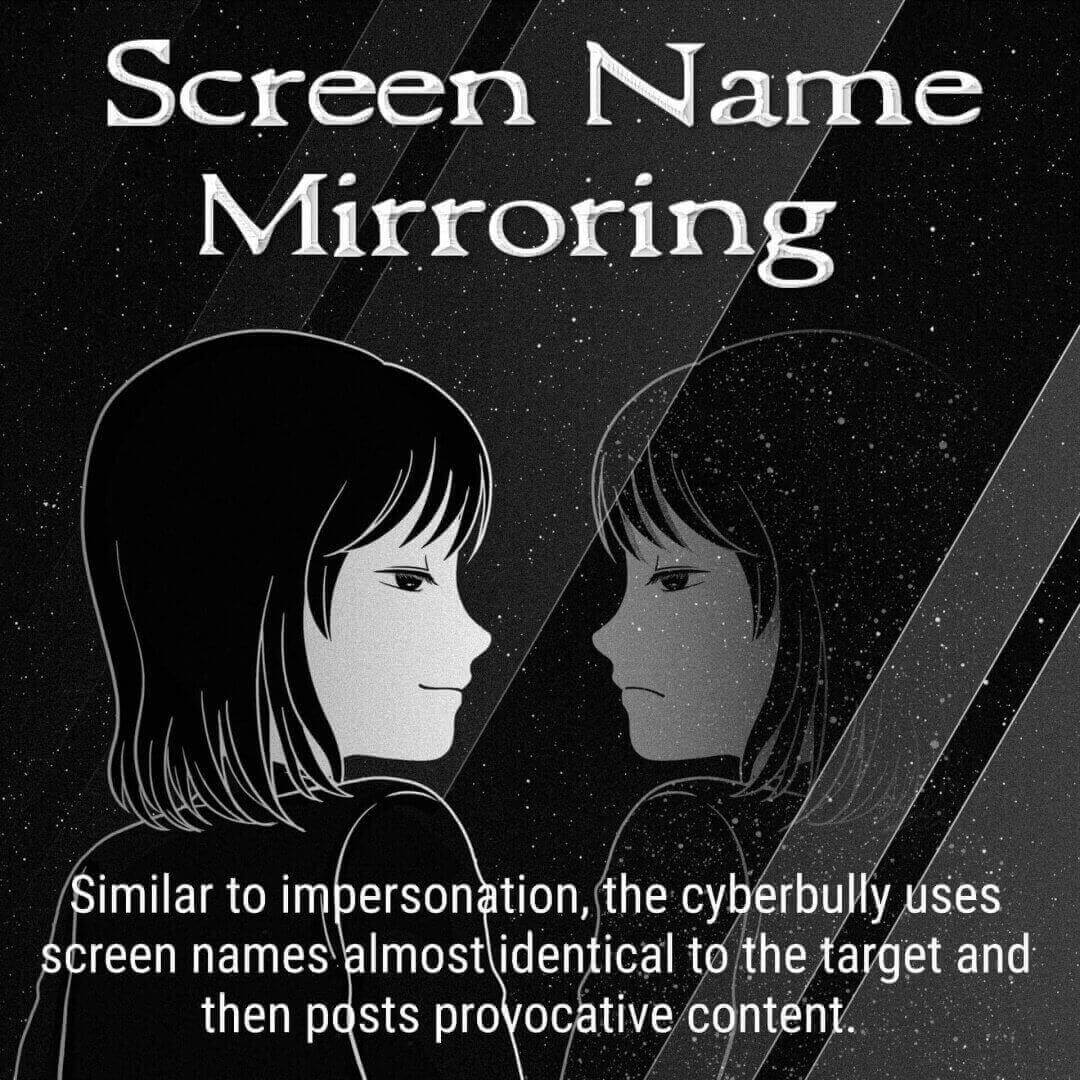Educational Examples of Cyberbullying Images
by Michael Nuccitelli, Psy.D.
Examples of cyberbullying describe the variety of techniques cyberbullies use to taunt, threaten, humiliate and deprecate their target. The primary goal for the reader is to become familiar with the strategies children use to mistreat other children.
Many of these tactics are also made use of by adult online users engaged in cyber harassment, cyberstalking and predatory trolling. As humanity increasingly becomes dependent upon mobile device technology, virtual reality and artificial intelligence; the range and complexity of cyber-attacks will assuredly grow.
Provided are examples of cyberbullying in image form. As with all the content on this website, they are free to download, share and use for informational and educational purposes. All images are 1080×1080 compressed JPEG files
Cyberbullying
Using Information and Communication Technology (ICT), cyberbullying is recurrent and sustained threats and taunts by one or more children towards another child who is unable or unwilling to deescalate the engagement. Cyberbullying is harmful, repeated and hostile behavior intended to deprecate a targeted minor.
Cyberbullying describes threatening or disparaging communications delivered through ICT. Whereas classic bullying typically involves face-to-face interactions and non-digital forms of communication, cyberbullying consists of information exchanged via ICT and may never involve face-to-face encounters.
.
Examples of Cyberbullying Images
Bash Boards: Defamatory content a cyberbully posts in chat rooms, online forums and message boards.
BlogoBullying: A cyberbully creates a blog and then makes their target the central character and topic of defamatory posts.
Cyberbullying by Proxy: Using deception, encouragement or manipulation; a cyberbully persuades other online users to harass their target.
Cyberstalking: When a cyberbully uses intimidation and persistent taunting that frightens their target
Cyber Drama: When a cyberbully posts melodramatic content to alarm or defame their target.
Cyber Harassment: When a cyberbully repeatedly contacts and sends defamatory messages to their target.
Cyber Threats: When a cyberbully falsely implies their target is in danger from unknown or nefarious assailants, which causes the target distress.
Denigration: When a cyberbully sends or publishes cruel rumors, gossip and false assertions about a target; trying to damage their reputation or friendships.
Digital Piracy Inclusion: When a cyberbully persuades their target to engage in illegal digital piracy and then reports them to the authorities, their parents or educators.
eIntimidation: A colloquial expression that describes when a cyberbully attempts to control their target using emails to manipulate them.
Exclusion: When a cyberbully informs their target that they are not invited to a social activity that other peers will be attending.
Exposure: Using social media, a cyberbully posts private communications, images or video about their target that is private and embarrassing.
Flaming: Using social media, a cyberbully provokes an argument with their target that includes profane and vulgar terminology.
Griefing: When a cyberbully frequents online gaming environments and frustrates their target by intentionally not following the rules.
Happy Slapping: While the target is physically attacked and simultaneously recorded; the images and video are posted online by the cyberbully.
Impersonation: The cyberbully mimics their target and posts defamatory comments on social networking sites and in chat rooms.
Instant Messaging Attacks: Using an instant messaging account, the cyberbully bombards the target with harassing and threatening text messages.
Interactive Gaming Harassment: Having the ability to exchange information with online gaming opponents; cyberbullies verbally abuse their targets and lock them out of games.
Malicious Code Dissemination: When a cyberbully sends malicious information like viruses, malware, spyware and ransomware to their target.
Micro-Visual Bullying: When a cyberbully creates and posts short videos to character assassinate their target.
Mobile Device Image Sharing: When a cyberbully sends sexually suggestive or embarrassing images of the target to peer mobile devices.
Non-Consensual Multimedia Bullying: The target does not know that embarrassing content is being disseminated by the cyberbully using various media formats.
Password Theft & Lockout: After a cyberbully steals & changes their target’s password, they impersonate them online and lock them out of their account.
Phishing: A cyberbully manipulates their target into revealing financial information and then purchases unauthorized items with their credit cards.
Porn & Marketing List Insertion: Using confidential online sign-up forms, the cyberbully signs their target up to multiple pornography and junk lists.
Pseudonym Stealth: Cyberbullies secretly change their online usernames and begin to taunt, tease and humiliate their target while hiding their identity.
Screen Name Mirroring: Similar to impersonation, the cyberbully uses screen names almost identical to the target and then posts provocative content.
Sexting: The cyberbully text messages sexually themed information about their target that is embarrassing and hurtful.
Sextortion: Using threats of revealing sexually themed content about their target, the cyberbully extorts them in exchange for not revealing the information.
Slut Shaming: The cyberbully records sexually suggestive images or videos of their target and distributes them throughout their school and online.
Social Media Bullying: The cyberbully persuades the target to include them in their “friends” or “buddy” lists, and then contacts their followers with derisive information.
Text Wars and Text Attacks: The cyberbully and accomplices engage their target in a series of provocative text messages using a cellular phone service.
Tragedy News Mirroring: The cyberbully announces that their target is planning to engage in a violent activity soon after a similar regional or national tragedy.
Trickery: The target is mistakenly led to believe that the sensitive information they share with the cyberbully will not be used for nefarious reasons.
Trolling: The cyberbully repeatedly taunts their target across multiple online environments ranging from online gaming to chat rooms.
Voting & Polling Booth Bullying: The cyberbully creates web pages that allow others to vote for categories deemed highly embarrassing to their target.
Warning Wars: The cyberbully makes frequent false allegations to an ISP seeking their target’s profile or account to be suspended.
Web Page Assassination: The cyberbully designs, and then posts web pages specifically intended to insult the target, their peers or loved ones.
VLE Bullying: In Virtual Learning Environments (VLE), cyberbullies use VLE message boards, chat rooms and instant messaging functions to ridicule their target.
Virtual World Bullying: Using their avatar in 3D websites and virtual worlds, the cyberbully taunts and teases their target by using their avatar as the assailant or provocateur.
X Pooping (Formally Twitter): The cyberbully repeatedly tweets harmful and provocative insults about the target using current “net lingo” terms.
YouTube Channeling: The cyberbully makes their target the principal character in a YouTube channel and publishes denigrating and disinformation-themed videos.
Michael Nuccitelli, Psy.D.
Michael Nuccitelli, Psy.D. is a NYS licensed psychologist, cyberpsychologist and online safety educator. In 2009, Dr. Nuccitelli finalized his dark side of cyberspace concept called iPredator. Since 2010, he has advised those seeking information about cyberbullying, cyberstalking, cybercriminal minds, internet addiction and his Dark Psychology concept. By day Dr. Nuccitelli is a practicing psychologist, clinical supervisor and owner of MN Psychological Services, PLLC. After work and on the weekends, he volunteers helping online users who have been cyber-attacked. Dr. Nuccitelli’s is always available to interested parties and the media at no cost. This website and everything created by Dr. Nuccitelli is educational, free and public domain.











































